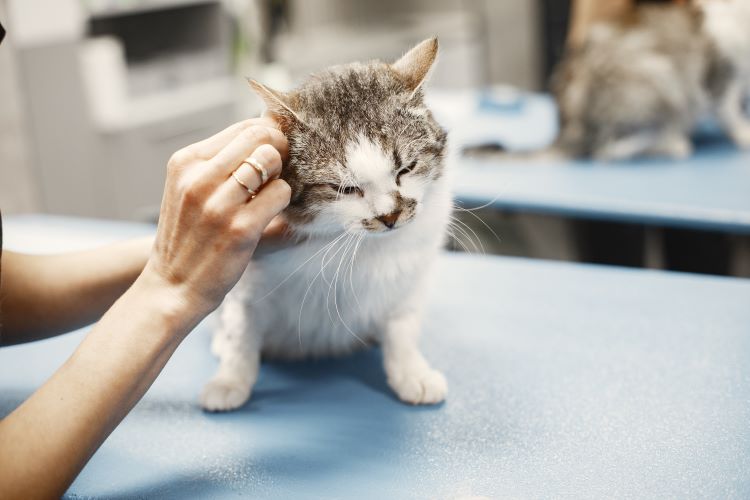Ready to help treat your pet to a healthy life?
Is My Pet Going Deaf? Signs to Watch For
By : Brianna Gunter | Published Sep 12, 2024

Nobody likes to think about a loved one losing their hearing, and this includes dogs and cats. The inability of a pet to hear you properly creates a unique set of challenges and can come as a surprise to many pet owners. After all, most forms of pet training revolve around verbal cues, and pet owners often talk to dogs and cats as a form of bonding and socialization.
Before you start worrying about how to handle pet deafness, you’ll need to confirm that it is actually affecting your furry family member. So, how can you tell that your pet is deaf or losing their hearing? Only a trained veterinarian can determine this for sure, but there are some key signs to watch for. Knowing your pet’s risk based on their genetics and lifestyle can also help ease worries and, in some cases, lead to swifter diagnoses. Let’s dive in!
How common is deafness in dogs and cats?
Sources on the prevalence of deafness in pets are limited, though the American Kennel Club estimates between 5- and 10% of dogs are affected. Estimates aside, evidence has been found for the connection between pet genetics and the likelihood of deafness. While older dogs in general are more likely to suffer hearing loss, certain dog breeds are now known to be at higher risk of congenital deafness (that’s when a dog is born with total or partial hearing loss). These include, but are not limited to:
- Australian Shepherds
- Cocker Spaniels
- Boston Terriers
- Dalmatians
- Jack Russel Terriers
- Maltese
- Poodles (specifically Toy and Miniature Poodles)
Additionally, dogs who enjoy swimming frequently are at higher risk of ear infections and other ocular illnesses, which may contribute to increased likelihood of hearing loss.
Things are a little less cut and dry for cats, and more research is needed on deafness in specific cat breeds. That said, a correlation has been found between feline eye color and congenital deafness. Researchers at the Cornell Feline Health Center found that no more than 22% of white cats with non-blue eyes are born with hearing loss (either in both or just one ear). Interestingly, this number increases to 40% if the cat has one blue eye, then 65- to 85% of all-white cats with blue eyes. Even more intriguing, white cats with only one blue eye and hearing difficulty in one ear tend to be deaf on the same side of their head as the blue eye.

6 signs of deafness in pets
Just a reminder — only a veterinarian can diagnose pet deafness. It’s also important to realize that deafness in dogs and cats can be subtle and may develop gradually or suddenly. While some pets are born deaf, others won’t experience hearing loss until years into their lifetime.
If you’re reading this of course, you already may suspect your own pet has been suffering from hearing loss. Here are some common signs of deafness in dogs and cats:
1. Lack of response to sounds
Dogs and cats alike tend to react to loud noises (doors slamming, vacuums, etc.) and familiar sounds like squeak toys and their names being called. Naturally, pets who are born deaf won’t react to sounds to begin with. But if your pet no longer perks up at hearing their name or has stopped getting up when someone rings the doorbell, it might indicate hearing loss.
2. Startling easily
Along with no longer reacting to sound, pets suffering from hearing loss may startle more easily when touched. This will especially be the case if they are approached from behind or otherwise can’t see the person or other pet coming their way.
If you’re unsure, try calling your pet’s name or making a sound behind them. If they don’t respond to that but jump at being touched afterward, there’s a good chance they didn’t hear you.

3. Sleeping deeply
A pet in deep slumber is nothing out of the ordinary. However, sleeping more soundly than usual can be a sign of deafness in pets. Deaf dogs and cats or pets who are going deaf may sleep more deeply and may not wake up to sounds (like footsteps, a voice, or a loud truck going by the window) like the average pet with full hearing. If physical touch wakes your pet but sound does not, it could be an indicator that their hearing isn’t what it used to be.
4. Behavioral changes
Hard-of-hearing pets may become more aloof or less aware of their surroundings, which could lead to some changes in their normal behavior. For example, dogs may start barking excessively because they are unaware of their own noise level or can’t hear other sounds. Cats may likewise meow loudly and frequently for the same reason.
5. Changes in head position or movements
Pets who could formerly hear but are now struggling to do so may start trying to position their ears in odd ways to catch sound vibrations. This could include head tilting and/or frequent ear changes when looking at moving or noisy stimuli. They may also just look confused when looking at things that make sound, especially if it’s something they’re familiar with.
Keep in mind that head tilting could indicate a wide variety of other health conditions, not just hearing loss. Always seek veterinary attention as soon as possible if your pet starts doing this.
6. Following vibrations or visual cues
Watch a deaf pet closely, and you may notice that they’re more sensitive to vibrations than pets with full hearing. They may react more to people walking around the floor they’re laying on, someone sitting on the other side of the couch from them, pats and hand clapping, etc. You may also notice them relying more on visual cues to navigate their environment.

When to talk with your veterinarian
If you suspect hearing loss in your pet, it’s always a good idea to have them checked by a veterinarian. They’ll be able to examine your pet more closely and confirm deafness or potential other causes of the signs you’ve been noticing. If your pet is suffering from hearing loss, their vet will want to diagnose the cause and determine appropriate treatment.
What if my pet is deaf?
Treatment for pet hearing loss depends on the cause. Some illnesses may be treatable, allowing pets to regain their hearing and make a full recovery. In other cases, hearing loss may be permanent but may be able to be slowed down or slightly improved. Cases of congenital deafness and loss of hearing with old age are generally not treatable, though lifestyle adjustments can make things easier for the animal and pet owner alike.
Pets born deaf as well as those who develop it later on often go on to live full, happy lives like other pets. Though still limited, resources for pet owners with a deaf dog or cat have come a long way in recent years. For example, canine sign language has gained broader recognition.
Pet deafness can be scary, but don’t panic. If you’re feeling overwhelmed and think you’ve been noticing some of the signs of pet deafness listed above, remember that getting veterinary care is the first step.
